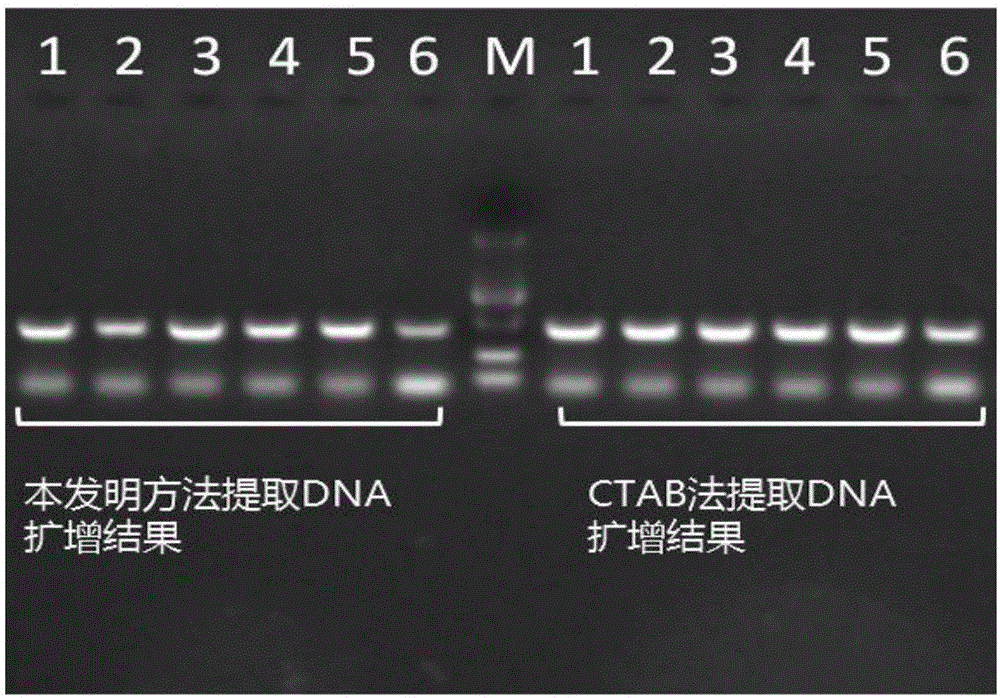Simplified method for rapidly extracting DNA from plant leaves
A plant leaf and extraction method technology, applied in the field of plant leaf DNA extraction, can solve the problems of high cost and low efficiency, and achieve the effect of simple instrument, simple and fast operation process, and easy operation
- Summary
- Abstract
- Description
- Claims
- Application Information
AI Technical Summary
Problems solved by technology
Method used
Image
Examples
specific Embodiment approach 1
[0023] Embodiment 1: This embodiment provides a simplified and rapid extraction method for plant leaf DNA. The specific steps are as follows:
[0024] 1. Sampling
[0025] Put 0.1-0.2g of fresh tomato or cucumber leaves directly into a 1.5mL centrifuge tube, and mark the sample name or serial number. The extraction within 48 hours can be stored at 4°C, and the extraction after 48 hours should be stored at -20°C, and do not freeze and thaw repeatedly.
[0026] 2. Grinding
[0027] Take an appropriate amount of quartz sand (due to the different quality of different batches of samples, you can pre-grind 1 to 2 samples, whichever is easier to grind the sample, the amount is not strictly required, but it is necessary to ensure that the amount of each sample is basically the same to facilitate subsequent centrifugation ) into the centrifuge tube containing the leaf sample, add 300μl, 0.4M NaOH solution, grind it directly with a sterilized 1000μl pipette tip until there is no obvio...
specific Embodiment approach 2
[0038] Specific embodiment 2: This embodiment takes the identification marker amplification of tomato Ty-2 gene as an example, and compares the experimental effects of the present invention and the traditional CTAB extraction method.
[0039] CTAB method extraction process:
[0040] (1) Grind the quick-frozen leaves in liquid nitrogen into powder with a sterile pipette tip. After grinding, quickly add 700 μL of CTAB solution preheated in a 65°C water bath, cover the lid and mix well.
[0041] (2) Place the mixed sample in a 65°C water bath for 1 hour, and turn the sample up and down every few minutes during the water bath to make it evenly heated and fully contact the tissue sample with the solution.
[0042] (3) After the water bath, the sample was taken out and cooled at room temperature. After cooling, 700 μL of chloroform: isoamyl alcohol (24:1) mixture was added, mixed evenly and allowed to stand for 10 minutes.
[0043] (4) Place the sample after standing in a centrifug...
PUM
 Login to View More
Login to View More Abstract
Description
Claims
Application Information
 Login to View More
Login to View More - R&D
- Intellectual Property
- Life Sciences
- Materials
- Tech Scout
- Unparalleled Data Quality
- Higher Quality Content
- 60% Fewer Hallucinations
Browse by: Latest US Patents, China's latest patents, Technical Efficacy Thesaurus, Application Domain, Technology Topic, Popular Technical Reports.
© 2025 PatSnap. All rights reserved.Legal|Privacy policy|Modern Slavery Act Transparency Statement|Sitemap|About US| Contact US: help@patsnap.com



